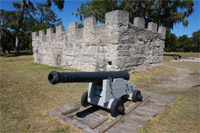 |

|
 |
 |

|
 |
 |

|
 |
 |

 |
Like any German city worth its salt, Moers (or Mörs, which is way cooler) had a schloss (castle). This castle was lovingy placed on an island in the mighty Rhine River, in the 12th century. |
 |

 |
 |
 |
The river worked its Rhinian magic in the late 13th century, however, and readjusted itself to flow about five miles to the east of Moers. This unexpectedly left the schloss in a low, marshy area, which turned out to be a great place to build a starfort! |
 |
 |
The Eighty Years' War (1568-1648) brought the Spanish, English and the "Oranges" (Dutch) To Moers: Spain held the town and built a lovely four-pointed starfort and outerworks, but the Siege of Moers (1597) won town and fort for Maurice of Orange (1564-1625). |
 |


The Siege of Moers, featuring the town's first starfort: Thanks, Spain! |
 |
 |
Maurice was known as a military innovator, and a firm believer in the utility of the modern starfort. His breathtaking example of the Dutch style of starfortification was built at Moers at the very start of the 17th century.
Moers became Prussian at the beginning of the 18th century, and was briefly occupied by the French during the Seven Years' War (1756-1763)...after which Prussia's Emperor, Frederick the Great (1712-1786) ordered that Moers' lovely Dutch starfort be destroyed, perhaps due to its proximity to France. The city's pretty starry walls survived this strategic slight because they were needed as a dike to keep the city above water. |
 |
|
|
|
 |
|
 |

|
 |
 |

|
 |
 |

 |
The British under General James Oglethorpe built Fort Frederica on St. Simon's Island, Georgia, in 1736. This was the largest British fortification in the Americas at the time, which it needed to be, because the Spanish were already heavily invested in Florida, the border with which was just 30 miles to the south. It wasn't a matter of if, but when the Spanish would attack.
Around 630 British troops were stationed at Fort Frederica, and 500 colonists populated the fortified area directly to the fort's east.
The expected attack came in 1742, when 2000 angry Spaniards landed on St. Simon's Island and headed for Fort Frederica. |
 |






 |
 |
 |
Oglethorpe's troops, including a number of Indians, met the attack with around 1000 men...and vanquished the wicked Spanish at the Battle of Bloody Marsh (July 7, 1742). Fort Frederica, and the British colony of Georgia, were saved. Today Fort Frederica National Monument does an excellent job of pointing out where important parts of the fort were, but relatively little of it remains. This did not prevent me from visiting and enpicting what I could in 2017, the results of which one can see at the Fort Frederica page in this site's Starforts I've Visited section. |  |
|
|
 |
Dread naught, there will be more. Though there probably won't be any Dreadnoughts.  HMS Dreadnought HMS Dreadnought |
|
 |


